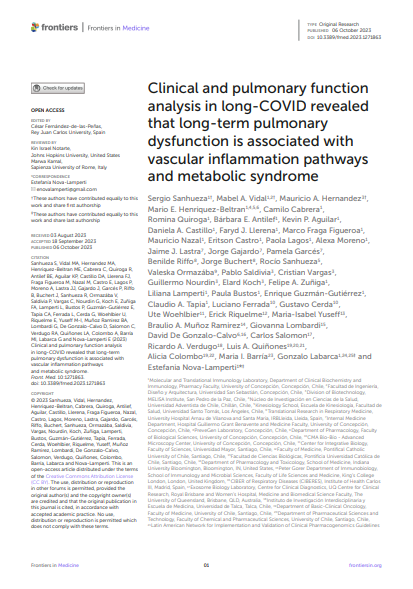Clinical and pulmonary function analysis in long-COVID revealed that long-term pulmonary dysfunction is associated with vascular inflammation pathways and metabolic syndrome

Fecha
2023-10Autor
Sanhueza, Sergio
Vidal, Mabel A.
Hernández, Mauricio A.
Henríquez-Beltrán, Mario E.
Cabrera, Camilo
Quiroga, Romina
Antilef, Bárbara E.
Aguilar, Kevin P.
Castillo, Daniela A.
Llerena, Faryd J.
Fraga Figueroa, Marco
Nazal, Mauricio
Castro, Eritson
Lagos, Paola
Moreno, Alexa
Lastra, Jaime J.
Gajardo, Jorge
Garcés, Pamela
Riffo, Benilde
Buchert, Jorge
Sanhueza, Rocío
Ormazábal, Valeska
Saldivia, Pablo
Vargas, Cristian
Nourdin, Guillermo
Koch, Elard
Zúñiga, Felipe A.
Lamperti, Liliana
Bustos, Paula
Guzmán-Gutiérrez, Enrique
Tapia, Claudio A.
Ferrada, Luciano
Cerda, Gustavo
Woehlbier, Ute [Center for Integrative Biology, Faculty of Sciences, Universidad Mayor, Chile]
Riquelme, Erick
Yuseff, María-Isabel
Muñoz Ramírez, Braulio A.
Lombardi, Giovanna
Gonzalo-Calvo, David de
Salomón, Carlos
Verdugo, Ricardo A.
Quiñones, Luis A.
Colombo, Alicia
Barría, María I.
Labarca, Gonzalo
Nova-Lamperti, Estefania
Ubicación geográfica
Notas
HERRAMIENTAS
Acceda a títulos restringidos
¿Cómo descargar?Resumen
Introduction: Long-term pulmonary dysfunction (L-TPD) is one of the most critical manifestations of long-COVID. This lung affection has been associated with disease severity during the acute phase and the presence of previous comorbidities, however, the clinical manifestations, the concomitant consequences and the molecular pathways supporting this clinical condition remain unknown. The aim of this study was to identify and characterize L-TPD in patients with long-COVID and elucidate the main pathways and long-term consequences attributed to this condition by analyzing clinical parameters and functional tests supported by machine learning and serum proteome profiling. Methods: Patients with L-TPD were classified according to the results of their computer-tomography (CT) scan and diffusing capacity of the lungs for carbon monoxide adjusted for hemoglobin (DLCOc) tests at 4 and 12-months post-infection. Results: Regarding the acute phase, our data showed that L-TPD was favored in elderly patients with hypertension or insulin resistance, supported by pathways associated with vascular inflammation and chemotaxis of phagocytes, according to computer proteomics. Then, at 4-months post-infection, clinical and functional tests revealed that L-TPD patients exhibited a restrictive lung condition, impaired aerobic capacity and reduced muscular strength. At this time point, high circulating levels of platelets and CXCL9, and an inhibited FCgamma-receptor-mediated-phagocytosis due to reduced FcγRIII (CD16) expression in CD14+ monocytes was observed in patients with L-TPD. Finally, 1-year post infection, patients with L-TPD worsened metabolic syndrome and augmented body mass index in comparison with other patient groups. Discussion: Overall, our data demonstrated that CT scan and DLCOc identified patients with L-TPD after COVID-19. This condition was associated with vascular inflammation and impair phagocytosis of virus-antibody immune complexes by reduced FcγRIII expression. In addition, we conclude that COVID-19 survivors required a personalized follow-up and adequate intervention to reduce long-term sequelae and the appearance of further metabolic diseases.
URI
https://repositorio.umayor.cl/xmlui/handle/sibum/9444https://www.ncbi.nlm.nih.gov/pmc/articles/PMC10590130/pdf/fmed-10-1271863.pdf
https://doi.org/10.3389/fmed.2023.1271863
https://www.frontiersin.org/articles/10.3389/fmed.2023.1271863/full
Coleccion/es a la/s que pertenece:
Si usted es autor(a) de este documento y NO desea que su publicación tenga acceso público en este repositorio, por favor complete el formulario aquí.